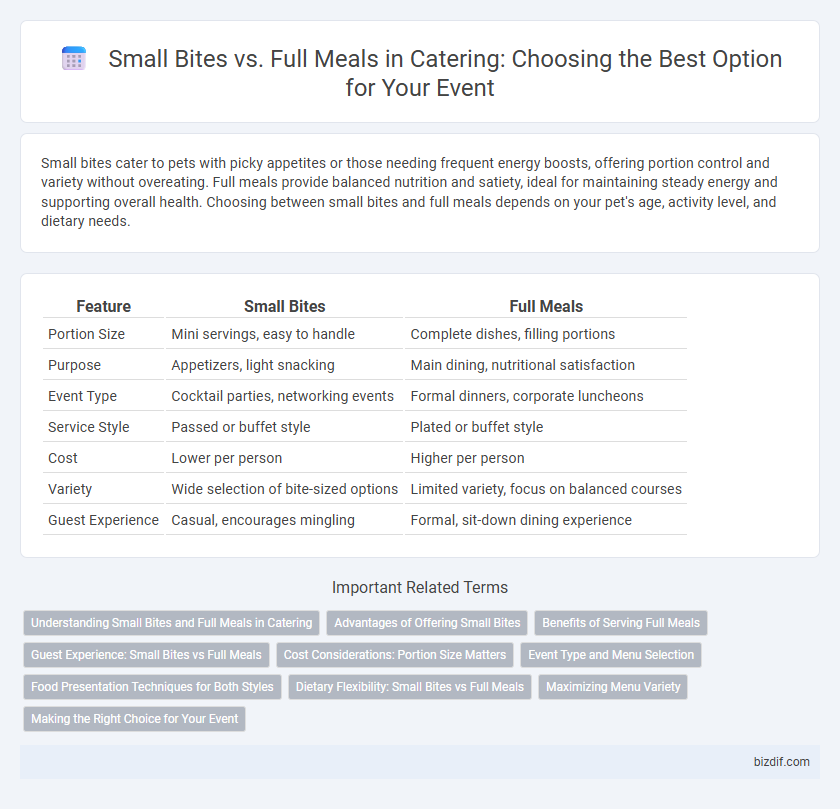Small bites cater to pets with picky appetites or those needing frequent energy boosts, offering portion control and variety without overeating. Full meals provide balanced nutrition and satiety, ideal for maintaining steady energy and supporting overall health. Choosing between small bites and full meals depends on your pet's age, activity level, and dietary needs.
Table of Comparison
| Feature | Small Bites | Full Meals |
|---|---|---|
| Portion Size | Mini servings, easy to handle | Complete dishes, filling portions |
| Purpose | Appetizers, light snacking | Main dining, nutritional satisfaction |
| Event Type | Cocktail parties, networking events | Formal dinners, corporate luncheons |
| Service Style | Passed or buffet style | Plated or buffet style |
| Cost | Lower per person | Higher per person |
| Variety | Wide selection of bite-sized options | Limited variety, focus on balanced courses |
| Guest Experience | Casual, encourages mingling | Formal, sit-down dining experience |
Understanding Small Bites and Full Meals in Catering
Small bites in catering refer to bite-sized, easy-to-eat portions often served during cocktail hours or networking events, offering guests variety and convenience. Full meals typically include multiple courses such as appetizers, main dishes, and desserts, designed to provide a complete dining experience within a formal or seated setting. Selecting between small bites and full meals depends on event type, guest preferences, and desired dining pace, ensuring efficient service and guest satisfaction.
Advantages of Offering Small Bites
Offering small bites in catering enhances guest experience by providing a variety of flavors and options that encourage social interaction and mingling. These portion-controlled servings reduce food waste and accommodate diverse dietary preferences more easily than full meals. Small bites also streamline service and presentation, making events more efficient and visually appealing.
Benefits of Serving Full Meals
Serving full meals in catering ensures guests receive balanced nutrition with appropriate portions of protein, carbohydrates, and vegetables, enhancing satisfaction and energy levels throughout the event. Full meals accommodate diverse dietary preferences, allowing for customization to meet vegetarian, gluten-free, or allergen-free requirements, promoting inclusivity. Compared to small bites, full meals reduce the need for frequent refills and minimize food waste by offering complete, carefully portioned dishes that maintain quality and presentation.
Guest Experience: Small Bites vs Full Meals
Small bites offer guests a variety of flavors and easier mingling, creating a more interactive and social atmosphere. Full meals provide a structured dining experience, ensuring guests feel fully satisfied and can enjoy a more formal setting. Choosing between small bites and full meals depends on the event type and guest preferences for comfort and engagement.
Cost Considerations: Portion Size Matters
Small bites offer a cost-effective catering option by reducing portion sizes and minimizing food waste, ideal for events with diverse dietary preferences. Full meals typically incur higher expenses due to larger portions, increased ingredient variety, and more labor-intensive preparation. Evaluating the balance between guest satisfaction and budget constraints ensures optimal cost management in catering decisions.
Event Type and Menu Selection
Small bites cater to networking events and casual gatherings by offering easy-to-eat, diverse options that encourage mingling and variety without the formality of a sit-down meal. Full meals are ideal for formal events, weddings, or corporate dinners where a structured menu supports a longer dining experience and guest satisfaction. Menu selection should align with the event's tone and duration, balancing portion size and presentation to meet guest expectations and event flow.
Food Presentation Techniques for Both Styles
Small bites in catering emphasize intricate food presentation techniques such as bite-sized portions arranged artistically on elegant trays, using garnishes, edible flowers, and colorful sauces to enhance visual appeal and encourage easy handling. Full meals rely on layering and plating strategies that balance color, texture, and portion size on individual plates, often incorporating height and negative space to create an inviting and sophisticated look. Both styles benefit from thoughtful arrangement, vibrant ingredients, and coordinated serving ware to elevate the dining experience and highlight the caterer's culinary creativity.
Dietary Flexibility: Small Bites vs Full Meals
Small bites offer greater dietary flexibility by allowing guests to sample a variety of flavors and accommodate different dietary restrictions such as gluten-free, vegan, or low-carb options without committing to a single dish. Full meals often require a fixed menu, which can limit the ability to cater to diverse nutritional needs and preferences. Catering services that prioritize small bites can enhance guest satisfaction by providing customizable portions that better align with individual dietary requirements and portion control.
Maximizing Menu Variety
Offering small bites instead of full meals increases menu variety by allowing more diverse options that cater to multiple tastes and dietary restrictions. Small bites promote flexibility in portion control and presentation, appealing to guests seeking lighter or customizable dining experiences. Incorporating a mix of seasonal ingredients and international flavors in small bites enhances overall menu appeal and satisfaction.
Making the Right Choice for Your Event
Choosing between small bites and full meals depends on your event's purpose, duration, and guest preferences; small bites encourage mingling and variety, ideal for cocktail parties or networking events. Full meals offer a structured dining experience suited for formal gatherings, ensuring guests feel satiated and comfortable throughout the event. Assessing factors like budget, venue logistics, and dietary needs helps tailor the catering style to enhance overall guest satisfaction.
Small Bites vs Full Meals Infographic

 bizdif.com
bizdif.com